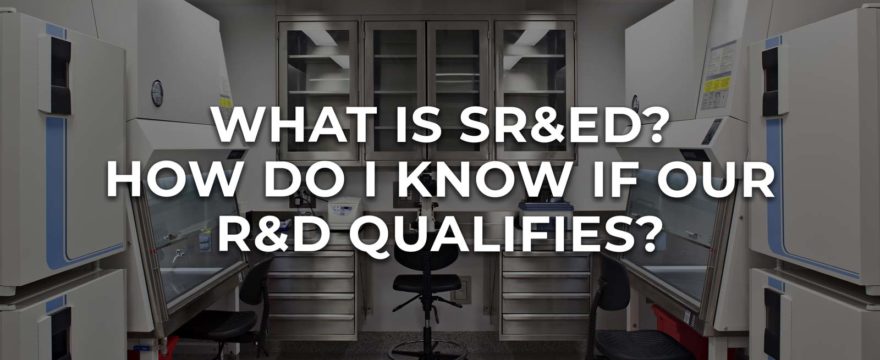
The Scientific Research and Experimental Development (SR&ED) tax incentive program is the largest source of financial support for research and development (R&D) backed by the Government of Canada. The majority of the organizations that receive these tax refunds are small businesses. Many companies wonder whether or not their work is eligible for SR&ED tax credits. This guide provides an in-depth overview of qualified SR&ED expenditures to help innovative organizations determine if the government tax incentive applies to their R&D projects.
What Is the Purpose of the SR&ED Program?
The government uses the SR&ED program to motivate businesses of all sizes and industries to conduct R&D in Canada. It strives to deliver these tax incentives consistently and predictably to give organizations more freedom when planning projects. Additionally, the program educates recipients on claiming SR&ED expenses while complying with established procedures, policies, and tax regulations.
Federal SR&ED incentives may either come as a refundable or non-refundable investment tax credit (ITC) or a deduction against income, depending on the capacity and type of business. Many provinces and territories also offer R&D tax credits, and each has separate guidelines regarding the type of refund and amounts an organization may receive. Organizations eligible for the SR&ED program fall into the following four classifications:
- Canadian-controlled private corporations: May obtain a refundable ITC at a 35% rate on qualified SR&ED expenditures up to their limit for the tax year or receive a non-refundable ITC at a 15% rate on amounts exceeding the limit
- Other corporations: Can claim a non-refundable ITC at a 15% rate on qualified SR&ED expenses
- Individuals and trusts: Can claim a refundable ITC at a 15% rate on eligible SR&ED costs. First the ITC must be applied to taxes payable, then the CRA will issue a 40% refund on the remainder of the ITC
- Members of a partnership: ITC is determined at the partnership level and then distributed to qualifying members
Businesses should determine their SR&ED expenditure limit to establish how much the CRA may extend in refundable and non-refundable tax credits.
What Are Qualified Expenditures?
For work to be eligible for SR&ED tax credits, it must advance scientific or technological knowledge. It also needs to include a systematic analysis or experiment conducted within an area of science or technology. This type of work generally falls into one of the three following categories:
- Basic research: Progresses scientific knowledge without having a defined practical application of the data
- Applied research: Advances scientific understanding and intends to put that information to use
- Experimental development: Accomplishes technological advancement to improve existing or design new products, materials, or processes
Other work that qualifies is tasks performed in support of the three primary categories. These eight activities include:
- Computer programming
- Data collection
- Design
- Engineering
- Mathematical analysis
- Operations research
- Psychological research
- Testing
What Does Not Qualify for Eligibility?
Some activities are not eligible for the tax refund, even if they are conducted in support of qualifying work. Efforts excluded from the SR&ED tax credit are:
- Style modifications
- Everyday data collection
- R&D capital expenditures
- Sales promotion and market research
- Investigations into social sciences or the humanities
- Commercialization of a new or enhanced product, device, material, or process
- Routine testing and quality control measures for products, materials, processes, and devices
- Searching for, drilling, or manufacturing natural resources (natural gas, minerals, and petroleum)
What Expenditures Can Businesses Claim?
Companies can include many costs when claiming SR&ED expenses. Some specific costs that the Canada Revenue Agency (CRA) considers eligible for the SR&ED investment tax credit include:
- Salaries and other wages
- Subcontractor fees
- Lease expenses for equipment
- Overhead costs
- Consumables
- Third-party payments
- Certain SR&ED expenditures occurring outside of Canada
If you believe that your business project is eligible for the SR&ED tax incentive program, you can submit Form T661 to claim the ITC. The deadline to submit this form is 18 months after the fiscal year ends for your company.
Accelerate Your SR&ED Refund with Easly
Tax refunds can be integral in enabling your business to pursue scientific or technological innovation, but accessing this support can be challenging. Since the program operates as a tax credit, it is only issued after the T661 has been submitted and reviewed. This can leave companies waiting over a year for reimbursement for eligible expenses. However, your organization can access these funds sooner with Easly Advances.
Easly works with businesses that obtain government funding, such as SR&ED tax refunds. We provide funding based on accrual, so you can start receiving funds at any time throughout the year. Our clients access this capital as on-demand and non-dilutive funding through our Capital-as-a-Service platform. Why wait up to 18 months to make use of your SR&ED refund? Use Easly Advances to accelerate your growth today.
Contact us today to learn more about qualified SR&ED expenditures and our product.
.png)
.png)
.png)
